2015 AUDI TT ROADSTER fold seats
[x] Cancel search: fold seatsPage 64 of 244

62 Seats and storage
-To reduce the risk of injury in the case of
sudden braking or accident, front pas
sengers must never ride in a moving ve
hicle with the seatback reclined. Safety
belts and the airbag system offer maxi
mum protection only when the seatback
is upright and the safety belts are prop
erly posit ioned on the body. The more
the seatback is reclined, the greater the
risk of personal injury from an incorrect
seating position and improperly posi
tioned safety belts!
- Always make sure the front seatbacks are
in the upright position and securely
locked in place when driving.
Head restraints
Adjusting head restraints, front seats
The head restraints must be adjusted proper
ly to provide protection .
Fig. 69 Dr iver's seat head rest rain t: adjusting the
heigh t
The head restraints on the front seats can be
adjusted to provide safe support to head and
neck at the optimum he ight . When optimally
adjusted, the top of the restra int should be
leve l with the top of the head
q page 94,
Proper adjustment of head restraints.
.,. Grasp the sides of the head restra int with
both hands and slide it upward/downward
until you feel it click into place
c> fig. 69 .
_&, WARNING
-Driving without head restraints or with
head restraints that are not properly ad-
-
justed increases the risk of serious or fa
tal neck injury dramatically.
- Read and heed all WARNINGS
q page 94, Proper adjustment of head
restraints.
t@ Tips
Correctly adjusted head restraints and
safety belts are an extreme ly effective
combination of safety features.
Luggage compartment
Pass-through with Ski Bag
Using the pass-through and the removable
ski bag, you can transport long objects (e .g.
skis) neatly and without damaging the interi
or.
Fig. 70 Open storage compartme nt between the seat
backs
Fig. 71 Retainer fo r the ski bag between the seatbacks
Loading
.,. Open the flip cover to the storage compart
ment between the seatbacks
c> page 66.
.,. To unlock it, pull the handle and fold the
cover of the pass-through to the trunk
c> fig. 70.
.,. Flip the cover upward in the direction of the
arrow.
Page 65 of 244
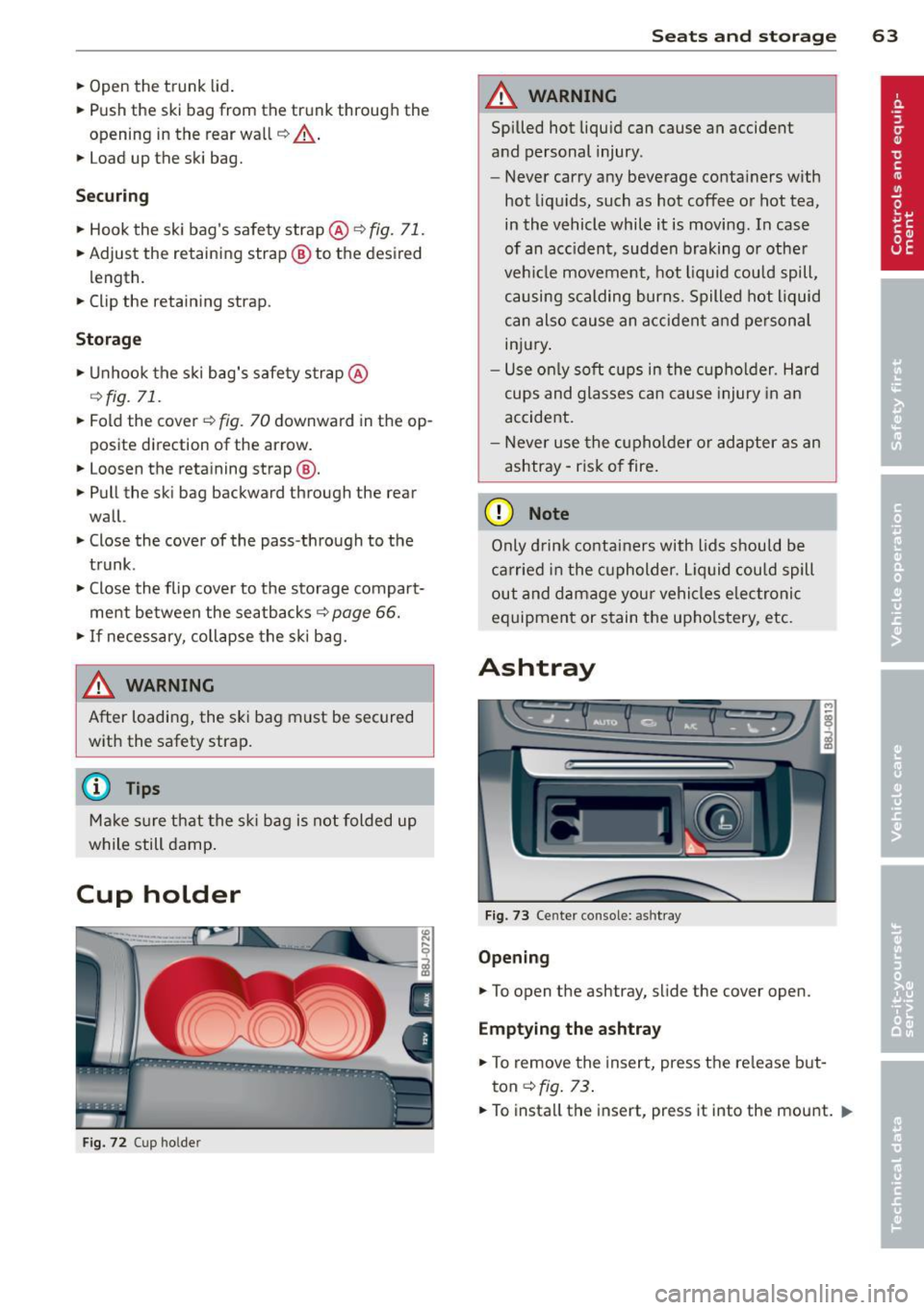
.. Open the trunk lid.
.. Push the ski bag from the trunk through the
opening in the rear wall
c!;> _& .
.. Load up the ski bag.
Securing
.. Hook the sk i bag's safety strap @ ¢ fig. 71.
.. Adjust the reta ining strap @ to the desired
length.
.. Clip the retaining st rap .
Storage
.,. Unhook the ski bag's safety strap @
¢fig. 71.
.. Fold the cover ¢ fig. 70 downward in the op
posite direction of the arrow.
.. Loosen the reta ining strap @ .
.. Pull the ski bag backw ard through the rear
wall.
.. Close the cover of the pass -through to the
trunk .
.. Close the flip cover to the storage compart
ment between the seatbacks ¢
page 66.
.,. If necessary, collapse the ski bag.
& WARNING ,-
After loading, the ski bag must be secured
with the safety strap.
@ Tips
Make sure that the ski bag is not folded up
while still damp.
Cup holder
Fig. 72 Cup holder
Seats and storage 63
A WARNING
Spilled hot liquid can cause an accident
and personal injury .
- Never carry any beverage containers with
hot liquids, such as hot coffee or hot tea,
in the vehicle while it is moving. In case
of an acc ident, sudden braking or other
veh icle movement , hot liquid could spill,
causing scalding burns. Spilled hot liquid
can also cause an accident and personal
injury .
- Use only soft cups in the cupholder. Hard
cups and glasses can cause injury in an
accident .
- Never use the cupholder or adapter as an
ashtray - risk of fire .
(D Note
Only drink containers with lids should be
carried in the cupholder. Liquid could spill
out and damage you r vehicles electronic
equipment or stain the upholstery, etc.
Ashtray
Fig. 73 Center co n sole: ashtr ay
Opening
.. To open the ashtray, slide the cover open.
Emptying the ashtray
.. To remove the insert, press the release but
ton
c:> fig. 13 .
.. To install the insert, press it into the mount . .,.
Page 66 of 244
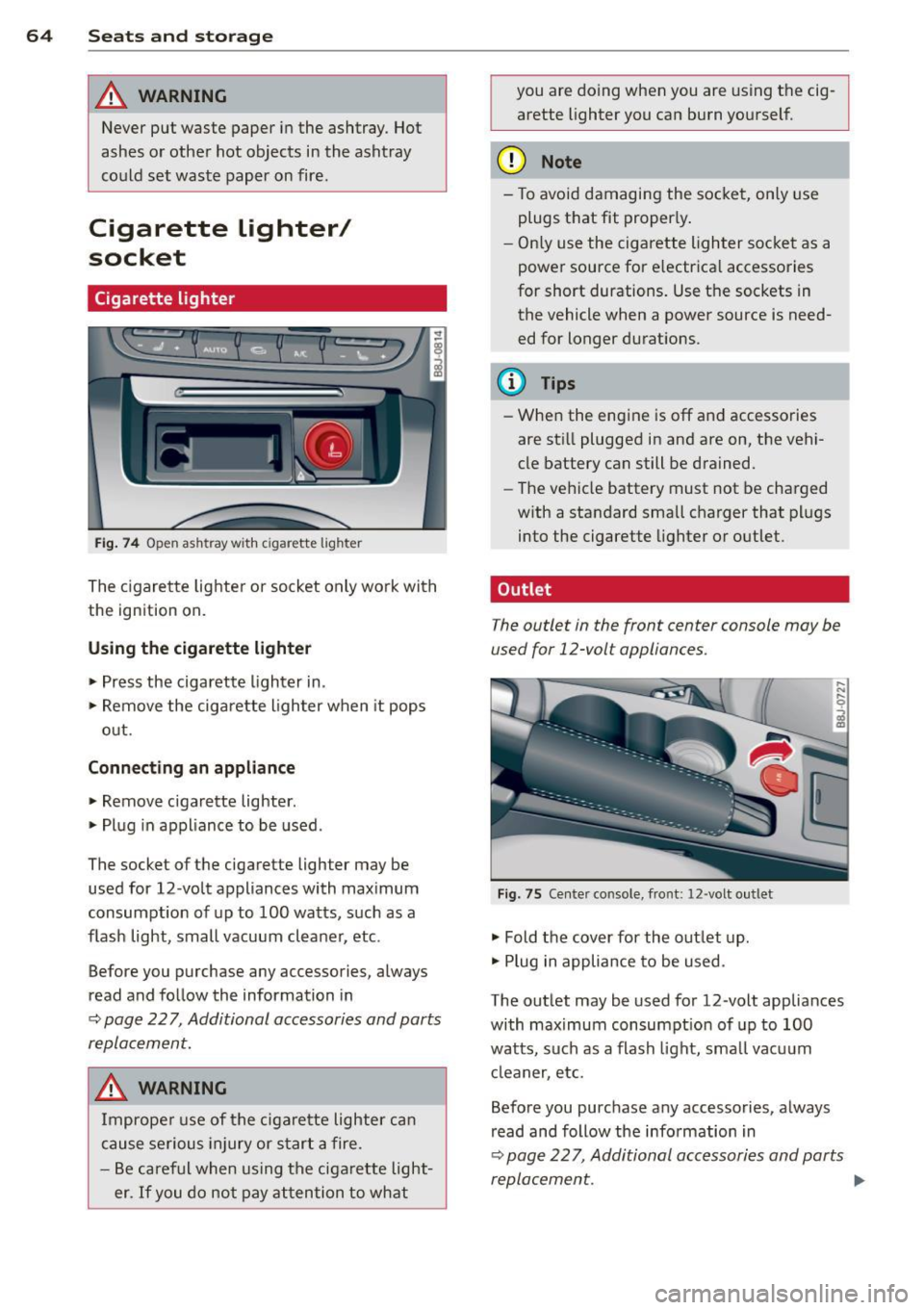
64 Seats and storage
A WARNING
Never put waste paper in the ashtray. Hot
ashes or othe r hot objects in the asht ray
co uld set waste paper on fire.
Cigarette Lighter/
socket
Cigarette lighter
Fi g. 74 O pen ash tray w ith c iga rett e ligh ter
The cigare tte lighte r or socket only work with
the ign ition on.
Using the cigarette lighter • Press the cigarette lighter in.
• Remove the ciga rette lighter when it pops
out.
Conn ecting an appliance
• Remove cigarette lighter .
• Plug in appliance to be used.
The socket of the cigarette lighter may be used for 12 -volt appliances with max imum
consumption of up to 100 watts, such as a
flash light, small vacuum cleaner, etc.
Before you purchase any accessories, always
read and follow the information in
~ page 22 7, Additional accessories and parts
replacement.
A WARNING
Improper use of the cigarette lighter can
cause serious injury or star t a fire.
- Be careful when using the ciga rette light
er.
If you do not pay attention to what you are doing when you are using t
he cig
arette lighter you can burn yourself.
(D Note
- To avoid damagi ng the socket, only use
plugs that fit proper ly .
- Only use the cigarette lighter socket as a
power source for e lectrica l accessories
for short durations. Use the sockets in
the vehicle when a power source is need ed for longer durations .
(D Tips
- When the engine is off and accessories
are sti ll plugged in and are on, the vehi
cle battery can still be drained.
- The vehicle battery must not be charged
w ith a standard small charger that plugs
into the cigarette lighter or outlet .
Outlet
T he outlet in the front center console may be
used for 12-volt appliances.
Fig . 75 Ce nter co nso le, fro nt: 12 -volt out let
• Fold the cover for the outlet up .
• Plug in appliance to be used .
The outlet may be used for 12 -volt appliances
with maximum consumpt ion of up to 100
watts, such as a flash light, small vacuum
cl eaner, etc.
Before you purchase any accessories, always
read and follow the information in
~ page 22 7, Additional accessories and parts
replacement . .,,.
Page 67 of 244

_& WARNING
The outlet plus any appliances plugged in
to it remain functional
even if the ignition
is switched off or the ignition key is re
moved. Never leave children inside the
ve
hicle without supervision.
(D Note
To avo id damag ing the socket, only use
plugs that fit properly.
@ Tips
When the engine is off and accessories are
still plugged in and are on, the vehicle bat
tery can still be dra ined.
Storage
General
_& WARNING
- Always remove objects from the instru
ment panel. Any items not put away
could slide around inside the vehicle
wh ile driving or when accelerating or
when applying the brakes or when driv
ing around a corner.
-
- When you are driving make sure that
anything you may have placed in the cen
ter console or other storage locations
cannot fall o ut into the footwells . In case
of sudden braking you would not be able
to brake or accelerate.
Seats and storage 65
Glove compartment
The glove compartment is illuminated and
can be locked .
i
----------- i
•
Fig . 76 Glove compartme nt
.,.. To open the glove compartment, pull the
handle in the direction of the arrow~
fig. 76
and swing the cover down to open .
.. To close the glove compartment, push the
glove compartment lid upward until the lock
engages.
The CD changer * for the Sound System is lo
cated in the glove compartment .
A WARNING
To reduce the risk of personal i njury in an
accident or sudden stop, always keep the
glove compartment closed while driving.
Storage compartment in the front seats
Applies to vehicles: with storage compartment in the
front seats
There is a fold-out storage compartment in
the front of the seats .
.. To open the storage compartment,
lift the
handle and pull the drawer out .
-
.. To close the storage compartment, push the
drawer in completely until it latches.
('.I) Tips
The maximum carrying capacity 2.2 lbs
(1 kg).
Page 95 of 244
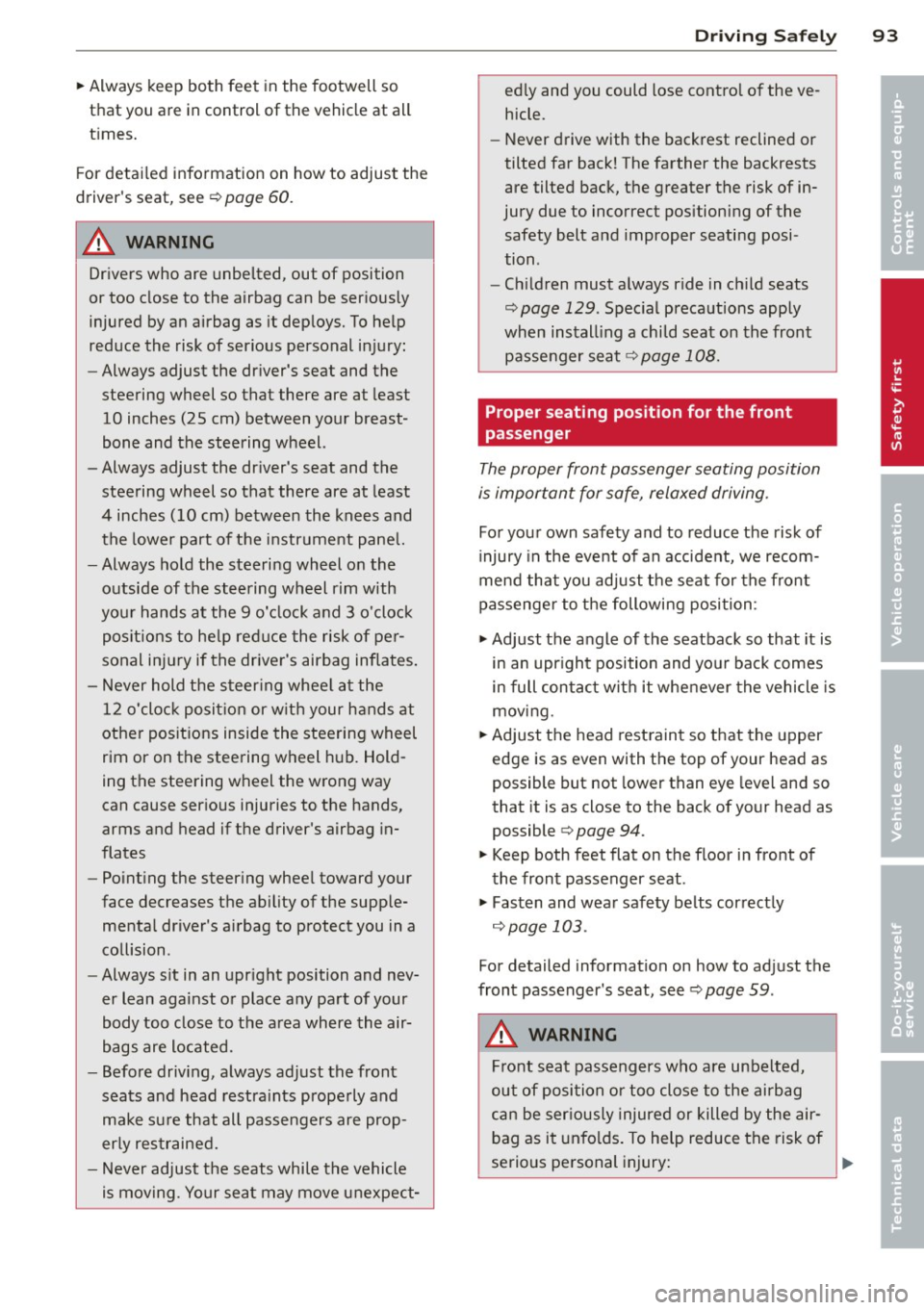
~ Always keep both feet in the footwell so
that you are in control of the vehicle at all
times.
For detailed information on how to adjust the
driver's seat, see
c:> page 60.
A WARNING
Drivers who are unbelted, out of position
or too close to the airbag can be seriously
injured by an airbag as it deploys. To help
reduce the risk of serious personal injury:
- Always adjust the driver's seat and the
steering wheel so that there are at least
10 inches (25 cm) between your breast
bone and the steering wheel.
- Always adjust the driver's seat and the
steering wheel so that there are at least
4 inches (10 cm) between the knees and
the lower part of the instrument panel.
- Always hold the steering wheel on the
outside of the steering wheel rim with
your hands at the 9 o'clock and 3 o'clock positions to help reduce the risk of per
sonal injury if the driver's airbag inflates.
- Never hold the steering wheel at the
12 o'clock position or with your hands at
other positions inside the steering wheel
rim or on the steering wheel hub. Hold
ing the steering wheel the wrong way
can cause serious injuries to the hands,
arms and head if the driver's airbag in
flates
- Pointing the steering wheel toward your
face decreases the ability of the supple
mental driver's airbag to protect you in a
collision .
- Always sit in an upright position and nev
er lean against or place any part of your
body too close to the area where the air
bags are located.
- Before driving, always adjust the front
seats and head restraints properly and make sure that all passengers are prop
erly restrained.
- Never adjust the seats while the vehicle
is moving. Your seat may move unexpect-
Driving Safely 93
ed ly and you could lose control of the ve
hicle .
- Never drive with the backrest reclined or
tilted far back! The farther the backrests
are tilted back, the greater the risk of in
jury due to incorrect positioning of the safety belt and improper seating posi
tion .
- Children must always ride in child seats
c:> page 129 . Special precautions apply
when installing a child seat on the front passenger seat
c:> page 108.
Proper seating position for the front
passenger
The proper front passenger seating position
is important for safe, relaxed driving .
For your own safety and to reduce the risk of
injury in the event of an accident, we recom
mend that you adjust the seat for the front
passenger to the following position :
~ Adjust the angle of the seatback so that it is
in an upright position and your back comes
in full contact with it whenever the vehicle is
moving.
~ Adjust the head restraint so that the upper
edge is as even w ith the top of your head as
possible but not lower than eye level and so
that it is as close to the back of your head as
possible
c:> page 94.
~ Keep both feet flat on the floor in front of
the front passenger seat .
~ Fasten and wear safety belts correctly
c:> page 103.
For detailed information on how to adjust the
front passenger's seat, see
c:> page 59 .
A WARNING
Front seat passengers who are unbelted,
out of position or too close to the airbag
can be seriously injured or killed by the air
bag as it unfolds. To help reduce the risk of
serious personal injury:
•
•
Page 96 of 244
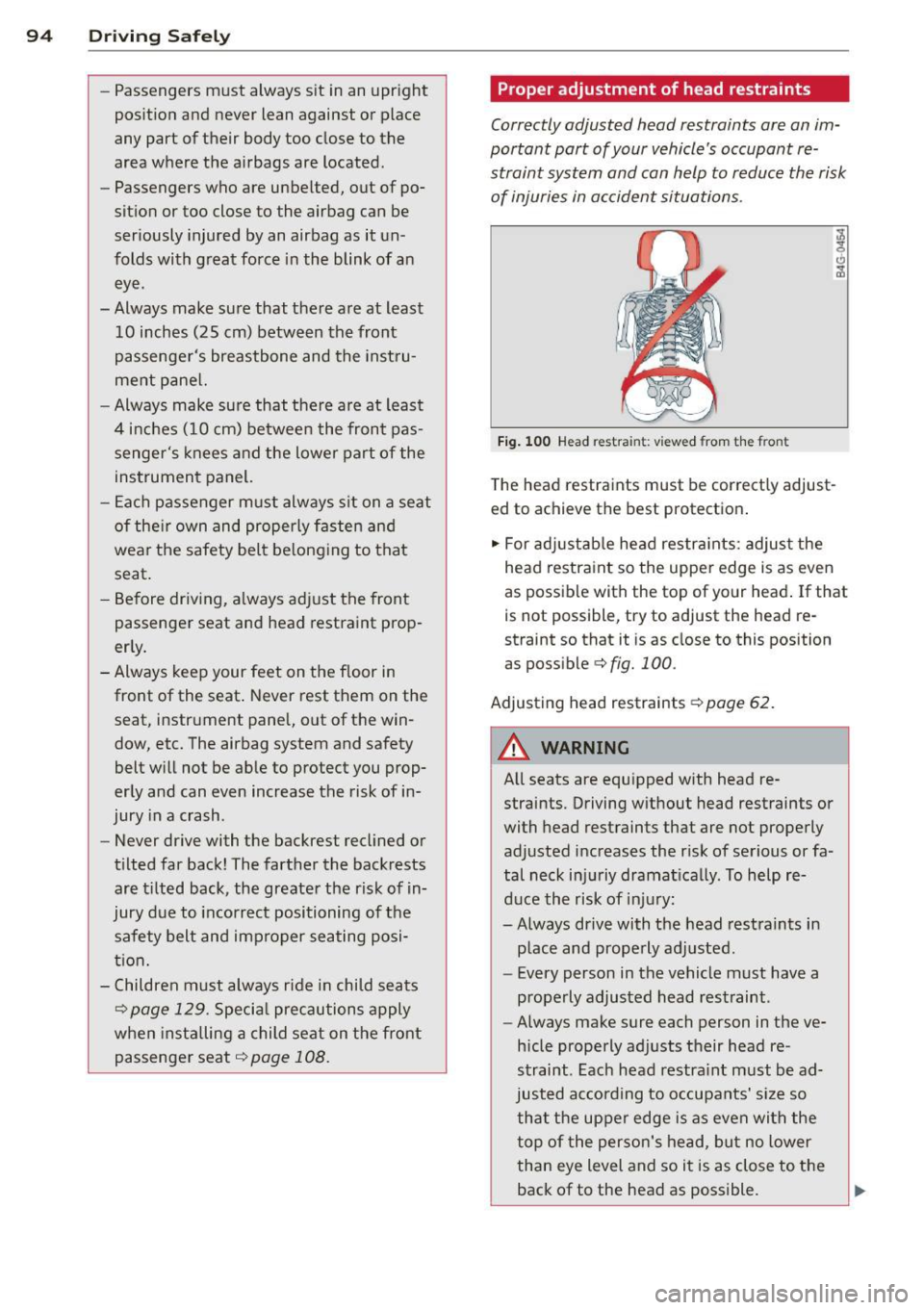
94 Driving Safely
-Passengers must always sit in an upright
position and never lean against or place
any part of their body too close to the
area where the airbags are located.
- Passengers who are unbelted, out of po
sition or too close to the airbag can be
seriously injured by an airbag as it un
folds with great force in the blink of an
eye.
- Always make sure that there are at least
10 inches (25 cm) between the front
passenger's breastbone and the instru
ment panel.
-Always make sure that there are at least
4 inches (10 cm) between the front pas senger's knees and the lower part of the
instrument panel.
- Each passenger must always sit on a seat
of their own and properly fasten and
wear the safety belt belonging to that
seat.
- Before driving, always adjust the front
passenger seat and head restraint prop
erly.
- Always keep your feet on the floor in
front of the seat. Never rest them on the
seat, instrument panel, out of the win
dow, etc. The airbag system and safety
belt will not be able to protect you prop
erly and can even increase the risk of in
jury in a crash .
- Never drive with the backrest reclined or
tilted far back! The farther the backrests
are tilted back, the greater the risk of in
jury due to incorrect positioning of the
safety belt and improper seating posi
tion.
- Children must always ride in child seats
¢
page 129. Special precautions apply
when installing a child seat on the front
passenger seat ¢
page 108.
Proper adjustment of head restraints
Correctly adjusted head restraints are an im
portant port of your vehicle's occupant re straint system and can help to reduce the risk
of injuries in occident situations.
Fig. 100 Head restra int: v iewed from the front
The head restraints must be correctly adjust
ed to achieve the best protection.
" For adjustable head restraints: adjust the
head restraint so the upper edge is as even
as possible with the top of your head. If that
is not possible, try to adjust the head re
straint so that it is as close to this position
as possible¢
fig. 100.
Adjusting head restraints ¢ page 62.
A WARNING
-
All seats are equipped with head re-
straints. Driving without head restraints or
with head restraints that are not properly
adjusted increases the risk of serious or fa
tal neck injuriy dramatically . To help re
duce the risk of injury:
- Always drive with the head restraints in
place and properly adjusted.
- Every person in the vehicle must have a
properly adjusted head restraint.
- Always make sure each person in the ve
hicle properly adjusts their head re
straint . Each head restraint must be ad
justed according to occupants' size so
that the upper edge is as even with the
top of the person's head, but no lower
than eye level and so it is as close to the
back of to the head as possible.
Page 119 of 244
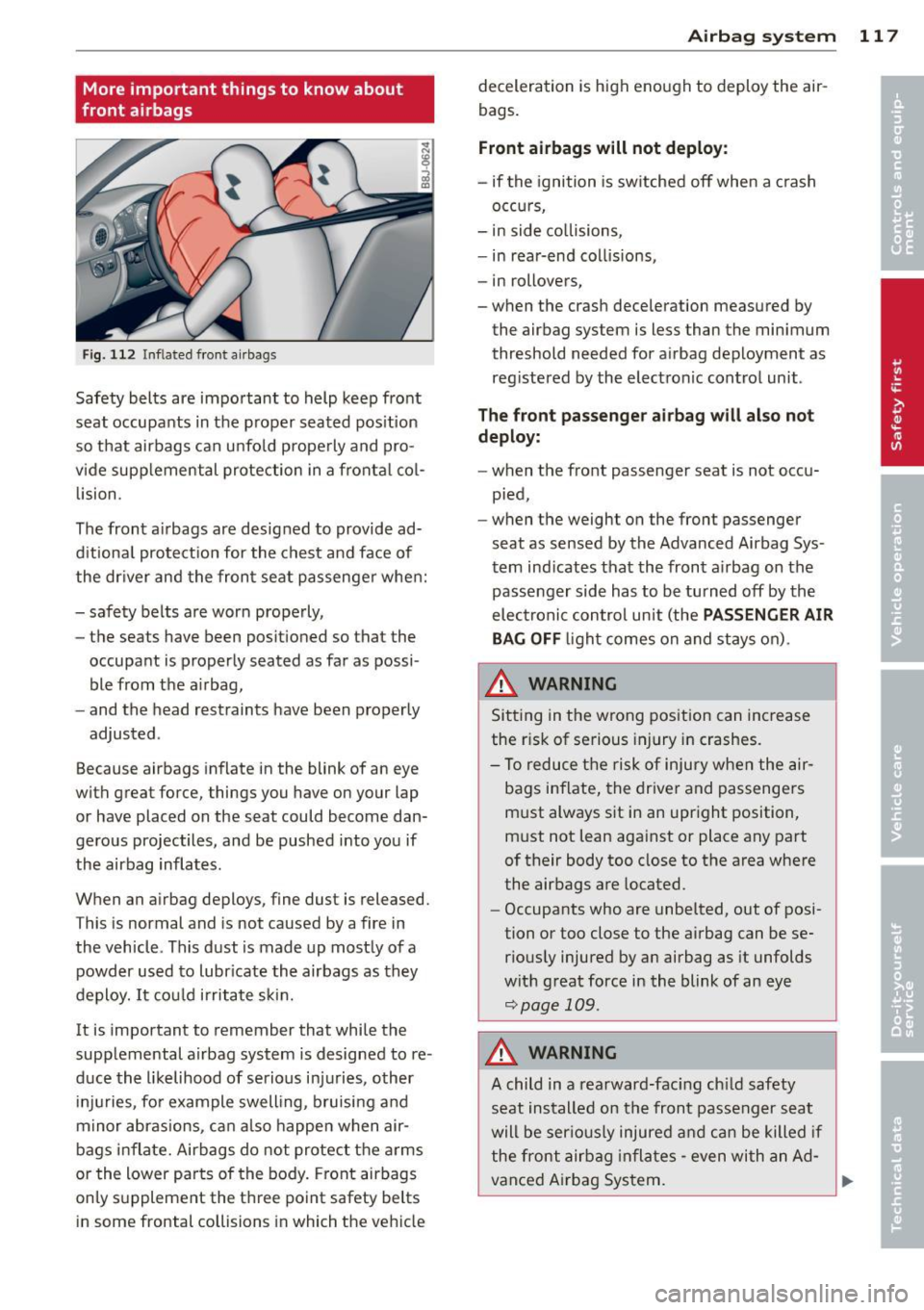
More important things to know about
front a irbags
F ig. 112 Inflated front airba gs
Safety belts are important to help keep front
seat occupants in the proper seated pos it ion
so that airbags can u nfold prope rly and pro
v ide supp lemental protection in a fronta l co l
lision .
The front a irbags are designed to provide ad
d itiona l protect io n for the chest and face of
the dr iver and the fron t seat passenger whe n:
- safety belts are wor n prope rly,
- the seats have been posit ioned so tha t the
occupant is proper ly seated as far as possi
ble from the a irbag,
- and the head restraints have been properly
adjusted .
Because airbags inflate in the blink of an eye
with great force, things you have on your lap or have placed on the seat could become dan
gerous projectiles, and be pushed into you if
the airbag inflates .
When an a irbag deploys, fine dust is released.
This is normal and is not caused by a fire in
the vehicle . This dust is made up most ly of a
powder used to lubr icate the airbags as they
deploy. It cou ld i rritate s kin .
It is important to remember that while the
supp lemental airbag system is designed to re
duce the likelihood of serious i njuries, other
inj uries, fo r example swell ing, bru isi ng a nd
minor abrasions, ca n also happen when air
bags inflate. Airbags do not protect the a rms
or the lower pa rts of the body. Front airbags
only s upplement the t hree point safety be lts
in some frontal collisions in which the vehicle
A irba g sy stem 11 7
deceleration is high eno ugh to deploy the air
bags .
Front airbags will not deploy :
-if t he ignition is sw itched off when a crash
occu rs,
- in side co llisions,
- in rear-end co llis ions,
- in rollovers,
- when the crash dece leration measured by
the airbag system is less than the minimum
threshold needed for a irbag deployment as
reg istered by the electronic con tro l unit .
The front pa ssenger airbag will also not
deploy:
- when the front passenge r seat is not occu
pied,
- when the weight on the front passenger
seat as sensed by the Advanced Airbag Sys
tem ind icates that the front a irbag on the
passenger side has to be tu rned off by th e
elec tronic con trol un it (the
PASSENGER AIR
BAG OFF
li ght comes on and st ays o n).
&_ WARNING ~
Si tti ng in the wrong pos ition can inc rease
the r isk of se rious in ju ry in crashes.
- To reduce t he ris k of injury when the air
ba gs inflate, the drive r and passenge rs
must always s it in an upr ight position,
m ust not lean against or place any part
of their body too close to the area whe re
the airbags a re located.
- Occupants who are unbe lted, out of posi
tion or too close to the airbag can be se rious ly injured by an airbag as it unfolds
with g reat force in the blink of an eye
~page 109 .
&_ WARNING
-
A child in a rearwar d-fac ing ch ild safety
seat installed on th e front passe nger seat
will be ser ious ly injured a nd ca n be killed if
the front ai rb ag inflate s - even wi th an Ad-
vanced Ai rbag Sys tem.
Ill-
Page 235 of 244
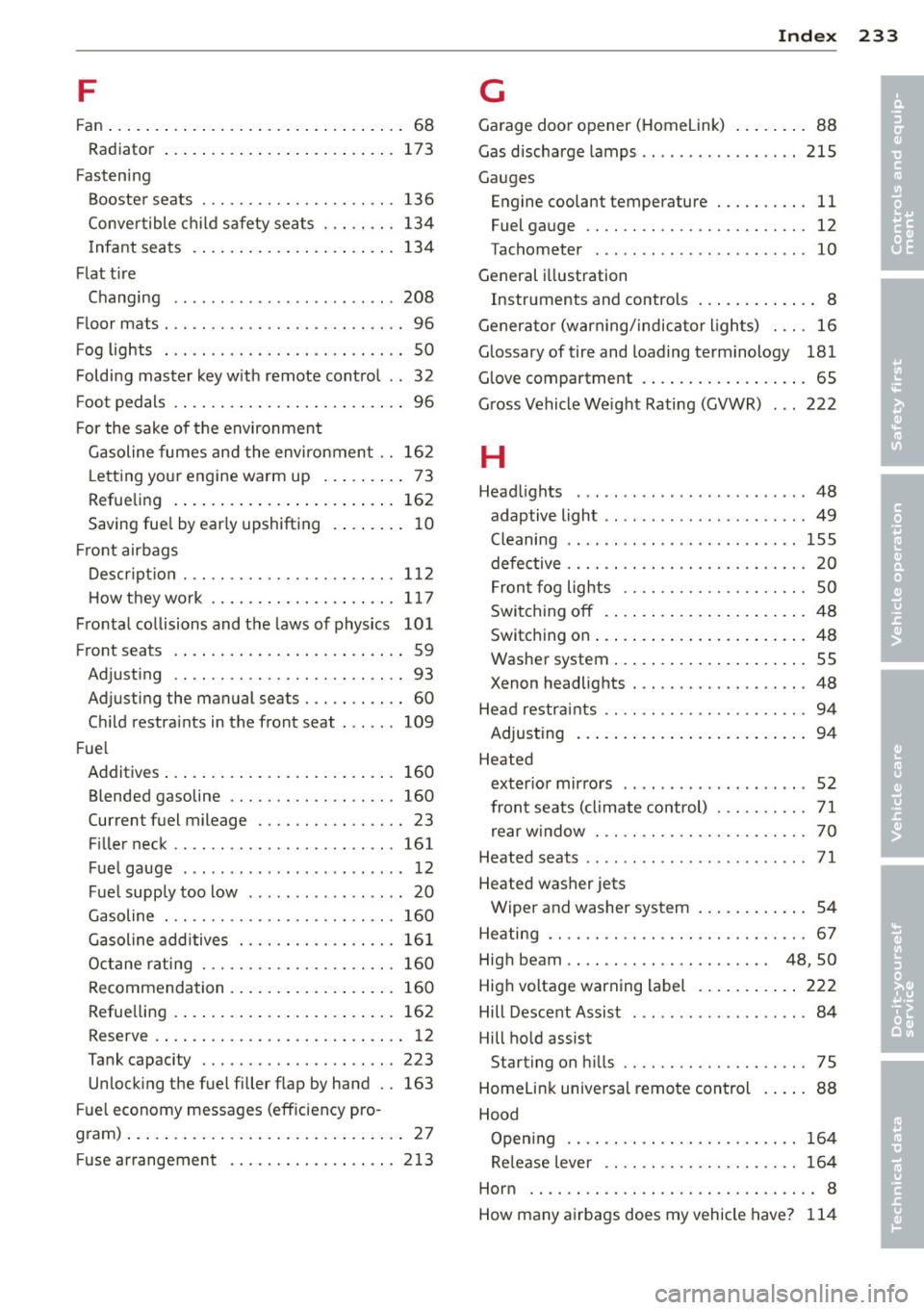
F
Fan ... .. .. .. .. .... .. .... ... .. .. .... 68
Radiator ... .. ... .. ..... ... .. .. ... 173
F astening
Booste r seats ............ .. .. .. .. . 136
Conve rtible c hild s afety sea ts . .. .. .. . 134
I nfant sea ts
Flat t ire 134
Changing .. .. .............. ... ... 208
F loor mats . . . . . . . . . . . . . . . . . . . . . . . . . . 96
F og lights . . . . . . . . . . . . . . . . . . . . . . . . . . 50
Foldi ng master key w it h remote contro l . . 32
F oot pedals . . . . . . . . . . . . . . . . . . . . . . . . . 96
F or the sake of the environmen t
Gasoline fumes and the environment . . 16 2
L e tt ing yo ur engine warm up ... .. .. .. 73
Refueli ng .. .. .. .. .. .... ... .. .. ... 162
Saving fue l by early upshifting . ... .. .. 1 0
Fr ont airbags
D escr ipt io n ... .. ......... .. .. .. ... 1 12
H ow they work . .. ..... ... .. .. .. .. . 11 7
Fronta l co llisions and the laws of physics 10 1
Front seats . . . . . . . . . . . . . . . . . . . . . . . . . 59
Adjusting .. ............. .... .. .... 93
Adjusting the manual seats . .. .. .. .. .. 60
Ch ild restra ints in the front seat ... .. . 109
Fu el
Additives ... .. .. .. .. .... ... .. .. ... 160
Blended gasoline ......... .. .. .. .. . 160
Current fuel mileage . . . . . . . . . . . . . . . . 23
F iller neck ................ ... ... .. 161
Fuel gauge . . . . . . . . . . . . . . . . . . . . . . . . 12
Fue l supp ly too low . . . . . . . . . . . . . . . . . 20
Gasoline . .. .. .. ......... .. .. .. ... 160
Gasoline additives ........ .. .. .. .. . 16 1
Octane rating ............ .. .. .. .. . 160
Recommenda tion . ..... ... .. .. .. .. . 160
Refue lling . ... .... .. .... ... .. .. ... 162
Reserve .... .. .. .. .. .... ... .. .. .... 1 2
Tank capacity . ........... .. .. .. .. . 223
Unlock ing the fue l filler f lap by ha nd . . 163
F ue l economy messages (eff iciency pro -
g ram) ..... .. .. .. .. .. .... ... .. .. .... 27
F use arrangement ......... .. .. .. .. . 213
Inde x 233
G
Garage door opener ( Home link) ... .. .. . 88
Gas d ischarge lamps .. . .. .. .. ... ... .. 215
Ga uges
Engine coolant temperature . . . . . . . . . . 11
Fuel gauge . . . . . . . . . . . . . . . . . . . . . . . . 12
Tachometer . . . . . . . . . . . . . . . . . . . . . . . 10
General i llustration
Instruments and controls .... ... .. .. .. 8
Generator (warning/ indicator ligh ts) . .. . 16
G lossary of tire and loading term inology 181
G love compartme nt . . . . . . . . . . . . . . . . . . 65
G ross Vehicle We ight Rating (GVWR) ... 222
H
Head lights ....... .. ..... ........... 48
adaptive light .. .. .. . .. .... .... .. .. . 49
Cleaning .. .. .... ... .. ... ... .... .. 155
defective . . . . . . . . . . . . . . . . . . . . . . . . . . 20
F ron t fog lights . . . . . . . . . . . . . . . . . . . . 50
Switching off . ..... . .. .. ..... ... .. . 48
Switching on ... .... . ... ...... ... .. . 48
Washer system . . . . . . . . . . . . . . . . . . . . . SS
Xenon headlights . .. ........... .... . 48
Hea d restr aints .. .... ... .......... .. . 94
Adjus ting ... .... .. . .. .. ..... ... .. . 94
Heated exter io r mir ro rs . . . . . . . . . . . . . . . . . . . . 52
fron t seats ( climate co ntrol) ..... .. .. . 71
re ar w indow ..................... .. 70
Heated seats .. .. .. .. . .. .... .... .. .. . 71
Heated washer jets Wiper and washer system .... ... .. .. . 54
Hea ting .... .. .. .. .... ............. . 67
Hig h beam . . . . . . . . . . . . . . . . . . . . . . 48, 50
Hig h voltage warning label .... ... .. .. 222
Hill Descent Assist . .. .. .. ...... .... .. 84
Hill ho ld assist
Start ing on hills .. ................. . 75
Homelin k unive rsal remote con trol . .... 88
Hood Open ing .. .. .. .. .... ............. 164
Re lease leve r .. .. ... ............ .. 164
Hor n .... .. .. .. .. .. ............... .. 8
How many airbags does my vehicle have? 114
•
•